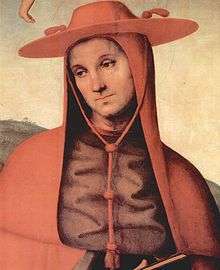Bernard degli Uberti
| Saint Bernardo degli Uberti O.S.B. Vall. | |
|---|---|
| Bishop of Parma | |
 Bernardo degli Uberti - Pietro Perugino. | |
| Church | Roman Catholic Church |
| Diocese | Parma |
| See | Parma |
| Appointed | October 1106 |
| Term ended | 4 December 1133 |
| Predecessor | Guido |
| Successor | Alberto |
| Other posts | Cardinal-Priest of San Crisogono |
| Orders | |
| Consecration |
November 1106 by Pope Paschal II |
| Created cardinal |
c. 1097 by Pope Urban II |
| Rank | Cardinal-Priest |
| Personal details | |
| Birth name | Bernardo degli Uberti |
| Born |
c. 1060 Florence, Tuscan Margrave |
| Died |
4 December 1133 (aged 73) Parma, Republic of Florence |
| Coat of arms |
|
| Sainthood | |
| Feast day | 4 December |
| Venerated in | Roman Catholic Church |
| Canonized |
3 December 1139 Old Saint Peter's Basilica, Rome, Papal States by Pope Innocent II |
| Attributes |
|
| Patronage |
|
Saint Bernardo degli Uberti (c. 1060 - 4 December 1133) was an Italian Roman Catholic prelate who served as an abbot and a professed member from the Vallumbrosan Order.[1][2] Uberti served as the Bishop of Parma from 1106 until his death and was appointed as a cardinal. He came from the noble Uberti house from Florence. Uberti served as a papal legate for successive popes in several Italian regions in their disputes with secular rulers and was a close confidante and advisor to the Countess Matilda.[3][2] He is often considered the third founding father for the order alongside Saint Benedict of Nursia (the order was a branch of the Benedictines) and Saint Giovanni Gualberto.
Uberti's fame for holiness became so great that miracles were reported on a frequent basis at his tomb. This led to Pope Innocent II naming Uberti as a saint not long after his death on 3 December 1139 in Rome.[3][2]
Life
Bernardo degli Uberti was born circa 1060 in Florence to the nobles Bruno degli Uberti and Ligarda. His paternal grandfather was Corbizo and he was the nephew to Blessed Pietro Igneo.[3]
Bernardo's father died sometime in 1085 and it was on 1 July 1085 that he made a donation to the San Salvi convent for his father's repose. But he also became a monk in the Vallumbrosans and he later made another donation for the repose of his father and grandfather on 26 April 1089.[3][2] He became the abbot for San Salvi (1092-1099) and was later elected as the Superior-General for the congregation in 1098 after the death of the abbot Almarius. On 7 March 1100 he presided over a meeting of all the order's abbots to discuss important resolutions on both organization and discipline.
Pope Urban II appointed him as a cardinal circa 1097 as the Cardinal-Priest of San Crisogono. He served as a papal legate in 1101 and began to serve as an advisor to Countess Matilda. On 7 April 1101 he was sent as a legate to Grosseto and on 4 May 1101 was with Matilda in Governolo where she restituted some lands to the pope upon his advice.[3] He was also a legate to Milan in 1102 to oversee the election of Grosulano as its archbishop while he was later a legate to Pavia on 18 August 1102.[1] He was also with the countess in Panzano on 18 October 1102 and travelled with her to Castro Panciano in March 1103. On 15 August 1104 he was in Parma in an attempt to keep the people faithful to the pope in his struggle against Emperor Heinrich V and the Antipope Maginulf but the people drove him into exile. Some sources state that he was in fact dragged from the altar in a violent scene.[2][4][1] He was exiled again in 1127 after opposing the proclamation of Conrad II.
In September 1104 he served as an advisor to the countess in both Cosogno and Modena while on 20 March 1105 he was in the Lateran Palace to sign a papal bull for the pope. Uberti tried to return to Parma in August 1105 to recruit troopers for the pope in his struggle against the German king but this venture proved unsuccessful.
He was later appointed as the Bishop of Parma in October 1106 at the Council of Guastalla where the pope made the announcement.[1] He received his episcopal consecration from Paschal II himself in Parma in November. In February 1111 he and Roman Curia were removed from Rome and imprisoned at the behest of the emperor. The pope too had been taken prisoner but it was the countess who managed to obtain their release. But Paschal II decided to crown the emperor and Uberti attended this event in Rome on 13 April 1113.[3] It was almost two decades later that he stood alongside Pope Innocent II when a schism loomed and the antipope Anacletus II attempted to gain control.
He died in his sleep on 4 December 1133 and was interred in the Parma cathedral. He was the subject of paintings that Bernardino Gatti and Pietro Perugino made.
Canonization
Uberti's canonization was solemnized on 3 December 1139 after Pope Innocent II proclaimed him to be a saint.[2] Pope Alexander VII and Pope Clement IX made extensions on his liturgical feast for the Parma diocese.[3]
References
- 1 2 3 4 "Saint Bernardo degli Uberti". Saints SQPN. 3 December 2015. Retrieved 27 September 2017.
- 1 2 3 4 5 6 "Saint Bernardo degli Uberti". Santi e Beati. Retrieved 27 September 2017.
- 1 2 3 4 5 6 7 Salvador Miranda. "Consistory celebrated in 1097 (VIII)". The Cardinals of the Holy Roman Church. Retrieved 27 September 2017.
- ↑ "Parma". Catholic Encyclopedia. Retrieved 27 September 2017.
External links
| Wikimedia Commons has media related to Bernardo degli Uberti. |